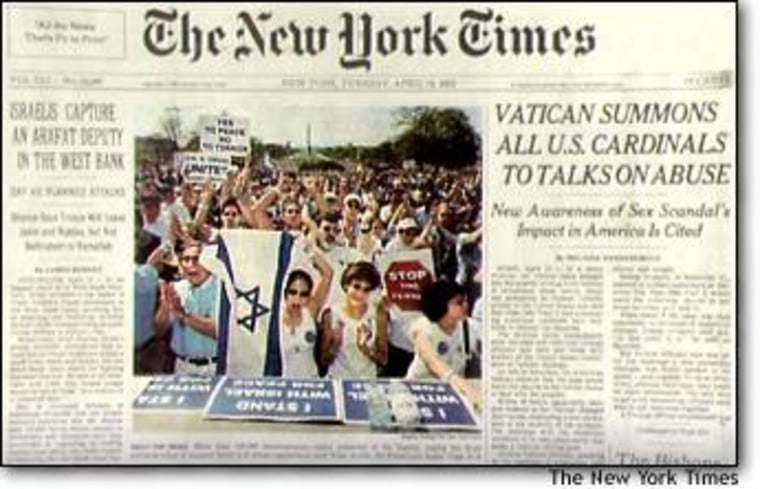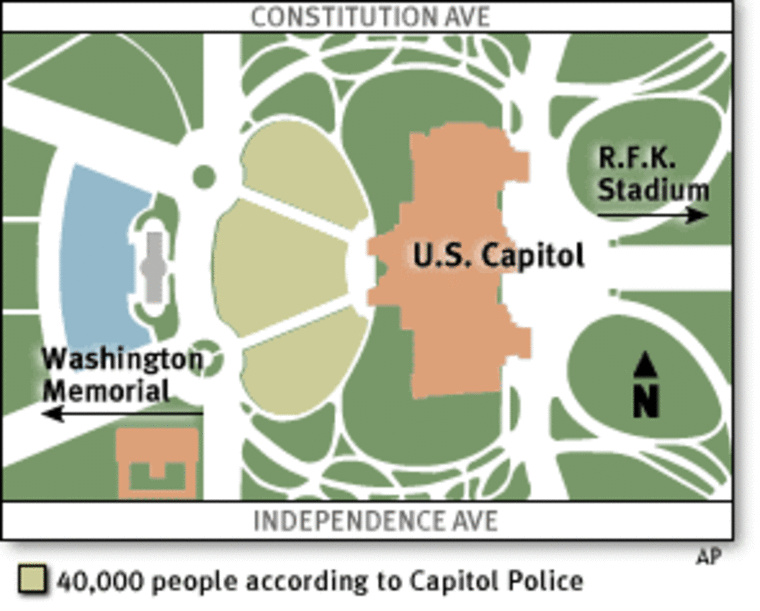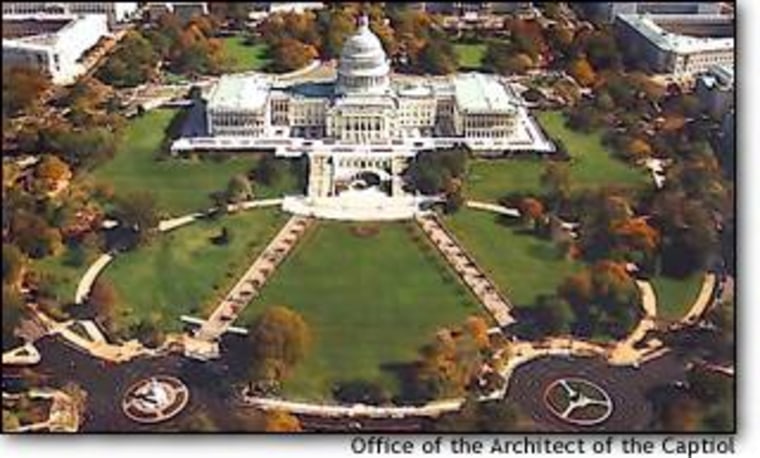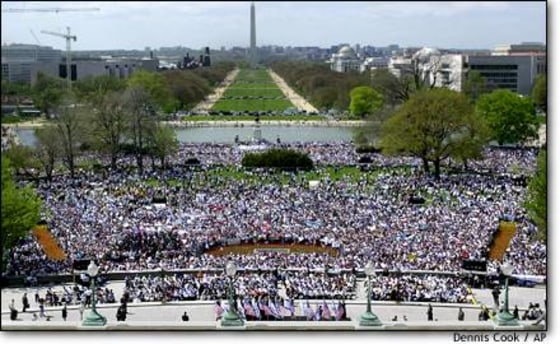Diane Sawyer’s voice conveys authority. On the morning after the April 15 pro-Israel rally in Washington, D.C., the ABC “Good Morning America” co-anchor introduced a segment about the American public’s views on the Mideast by stating as fact that the day before, “100,000 demonstrators held what they called the largest pro-Israel rally ever.”
The same figure appeared on the front page of The New York Times that morning under a photograph taken from the steps of the U.S. Capitol that suggested a crowd as far as the eye could see. The caption read: “Over 100,000 rally for Israel at the Capitol.” But the story on page A18 reported the crowd as being in the “tens of thousands.” In fact, the 100,000 figure is never mentioned.
What's in a number?
Generally, estimates of such events vary. But in the white-hot debate over the Middle East, assigning a larger number to one side or another is often viewed conspiratorially by those who come out on the short end. It can also be an indication that one side is doing a better job of getting its message out.

Does it really matter? Bob Thompson, a professor of media and popular culture at Syracuse University, says yes.
“The protest and coverage become one,” he said. “The decision to have a rally is the fact that you will be covered. It’s all one event.”
Last week, The New York Times told MSNBC that it does not stand by the 100,000 number. Toby Usnik, the Times’ director of public relations, said “it was a failure of coordination on one of our desks.”
“It was an estimate,” he said. “We are comfortable with tens of thousands, but do not feel that our estimate should become the basis of anything firmer.”
“Good Morning America” spokespersons did not respond to several requests for comment.
From 20,000 to 100,000
The Capitol police, who were responsible for overseeing the pro-Israel rally on April 15, know all too well how controversial such numbers can be. As a result, for years now it has been their policy to refuse to estimate crowd sizes. But their spokesperson, Lt. Dan Nichols, did share pertinent information. He said the rally’s organizers, the Conference of Presidents of Major American Jewish Organizations, said in its permit application that it expected 20,000 people.

The police department designated the Capitol’s west lawn for the assembly. Nichols described the lawn’s “three panels” as having “a capacity of roughly 40,000 people — with several areas for spillover.” Nichols said there are too many variables in the spillover areas to provide a good count.
As a result, accounts of attendance that day varied widely. NBC News correspondent Joe Johns put the crowd “in the tens of thousands, possibly 30,000 — 40,000.” Later, after the peak of the rally, he called it “a massive rally, tens of thousands of people.”
“The people at the podium have suggested that 100,000 or 200,000 people have been here,” Johns added.
The Washington Post and the St. Louis Post also cited the 100,000 figure — attributing it to unidentified police or unidentified officials. The Los Angeles Times quoted organizers as saying the crowd was at least 100,000 but the paper specifically described the parameters of the crowd in a way that was consistent with a smaller estimate.
Political calculus
To be sure, there was spillover at the rally on April 15. Nichols said that crowds typically flow onto the sides of the three panels of the west lawn, down by the wading pool and into a park north of Constitution Avenue. An extensive review of photographs and videotape acquired by MSNBC shows no evidence of spillover that would be 150 percent greater than the crowd in the designated areas.
Comparing photos with maps suggests spillover may have been in the 10,000 to 20,000 range. That would put total attendance in front of the Capitol at 50,000 to 60,000 — the high end of figures heard most often in dozens of phone calls to police agencies in Washington, D.C., veteran reporters and local broadcast journalists.
So how did the 100,000 figure appear as fact on the front page of the New York Times? Reporter Diana Jean Schemo says that an early draft of a story included the 100,000 number along with a thorough explanation of what it was based on: mass transit figures, data from police, comments of attendees and organizers.
Numbers count
Reports of big turnout boosts both the cause and the reputation of the organizers, in this case, the Conference of Presidents of Major Jewish Organizations. Malcolm Hoenlein, vice chairman of the group, told MSNBC a few days after the rally he believes the crowd might have been up to 200,000 strong. Schemo cited Hoenlein’s estimate that the crowd was “over 150,000” as one of many factors that led to the 100,000 figure under the Times’ page one photo.
To those who know Washington, “influence” is Hoenlein’s middle name. Writing in the American Prospect, Michael Massing, a former editor of the Columbia Journalism Review, presents Hoenlein as one of the most influential lobbyists in Washington. The Forward, the Jewish weekly, suggests that Hoenlein may be “the most influential private citizen in American foreign policy making.”
Reverse effect?
Almost inevitably, those demonstrating on behalf of the Palestinians see in the American media a tendency to inflate their rival’s crowd numbers and low-ball pro-Palestinian rallies.
A.N.S.W.E.R. — Act Now to Stop War and End Racism — is the organizer of several recent pro-Palestinian rallies. The group’s spokesman, Tony Murphy, says that several times in recent weeks, including the demonstration in Times Square in New York City on April 12, the group’s rallies have been undercounted or simply ignored by the media.

He’s ready with examples: News video from April 12th shows a Times Square crowd four blocks long that appears to number thousands — consistent with a New York police officer’s estimate of a “3,000-plus” turnout; it was reported as “hundreds” or “over 500” in various Associated Press reports.
Then there’s the rally of April 20. A.N.S.W.E.R. estimates that more than 100,000 people gathered in Washington, D.C., for the largest show of support for Palestinians ever in this country. The Washington Post gave the story front-page coverage and, citing an unidentified police source, put the crowd at 75,000 or more. The Associated Press account, seen in Sunday morning newspapers across the country, used the lowest of several estimates given that day by Washington police Chief Charles Ramsey, 35,000 to 50,000.
Kelly Smith Tunney, a spokesperson for The Associated Press, says that a reporter’s numbers depend on many factors: time, location, and crowd flow. “Most journalists try to be fair,” she said, but that’s not always what organizers believe.
The New York Times late edition, in a story and photograph on page A13, put the number at “tens of thousands.”
For those on the losing end of such decisions, this is not just minutiae.
Todd Gitlin, a professor of culture and journalism at New York University, who has been writing about media for decades, says, “You can follow a New York Times’ story right through the (news) food chain.”
Gitlin says that competing crowd sizes become an inevitable weapon in bragging rights. “If I got 5,000 at my last rally, you’ve got to get 6,000 or you’re ho-hum.”
Additional reporting by intern Rob Morlino, a student at Columbia University’s Graduate School of Journalism.
